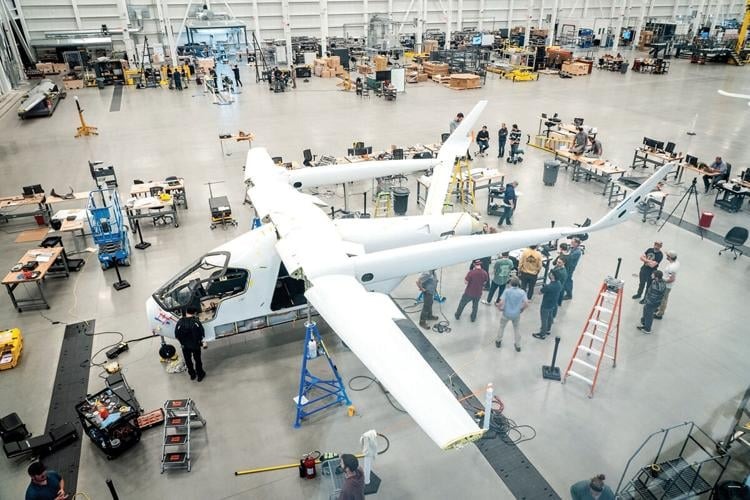

This story by Liberty Darr was first published in The Other Paper on Nov. 27
If you were out and about on Nov. 13 in South Burlington, it’s likely you didn’t see a bird or any old regular plane flying in the sky, but the first electric plane produced at Beta Technologies’ South Burlington production facility.
Just over a year after the company opened its doors to community, state and federal leaders celebrating the opening of the 188,000 square-foot facility located off Airport Parkway, the team successfully completed the first flight of the production aircraft, the Alia CTOL, when the company’s CEO and test pilot, Kyle Clark, sailed to 7,000 feet.
“It’s been a pretty remarkable year to look back on it,” Blain Newton, the company’s chief information officer. said. “Obviously seeing that aircraft come off the line was incredibly inspiring.”
The expansive manufacturing space now looks much different than it did last October. In that time, the company has installed aerospace-grade tooling for aircraft assembly and ground support equipment and started production of propulsion, batteries and other systems. Not to mention that the manufacturing floor is now alive with roughly 100 people at a time tinkering and perfecting aircraft design and manufacturing.
The company has hired just over 250 people this year alone, bringing its total employees up to 800 with most of them based in Vermont.
While the take-off of the fixed-wing plane marked a milestone for Beta, the company has also been laser-focused on how to effectively “build the machine to build the machines.”
The goal is to be able to produce roughly 300 electric planes a year. An even bigger goal is getting the Federal Aviation Administration to certify the fixed-wing aircraft by the end of next year.
“It’s the same level of discipline and care and engineering that goes into it, in fact, maybe more because of the number of dimensions,” Newton said. “One, let’s learn how to build aircraft in a high quality, safe way, alongside our partners in the FAA, to ensure that these aircraft are as safe as any aircraft coming off commercial airline production lines today. Then the rest of it has been spent on really learning how these aircraft come together in an optimized way.”
While Newton said there are hundreds of companies working in the electric aircraft realm, Beta’s mission is more expansive than the common concept of “urban air mobility” or just moving passengers over city traffic.
For example, the company announced in September that it had received $20 million to partner with U.S. Department of Health and Human Services to deploy 20 of the company’s battery charging stations along the Gulf Coast and in rural places like Mississippi and Arkansas as a means of powering public health preparedness.

“Well, that’s not really an urban air mobility mission, right? You’re not flying people over traffic in rural Mississippi,” Newton said. “What you’re doing is you’re opening and changing the paradigm of rural health access. You’re allowing more services to be provided because you bring the cost dramatically down from flying a helicopter in and you also set up preparations for disaster response by having infrastructure built to support it.”
While the company can certainly do urban air mobility — imagine flying from Rutland to New York City — that’s not the primary mission, he noted.
“So, to me, that mission highlights why we’re different,” he continued.
The company also recently signed with Air New Zealand to use its fixed-wing aircraft to move mail into rural communities.
“The reason they’re doing that is to get the folks in those communities accustomed to electric aviation that is safe, reliable, quiet, cost-effective,” he said. “Then they want to move to passenger movements so that folks that are isolated in those rural communities can now start to access the rest of the country.”
The company, he said, elected to build the fixed-wing model first because it is likely first in the FAA certification schedule and likely first to be delivered to customers. But the company has always set out to build a vertical takeoff and landing aircraft like a helicopter.
“What we saw as we were out doing our flight tests, and we’ve now flown over 90 airports in the U.S. and Canada, is that people still have the desire for a low-cost, quiet, reliable, safe, conventional aircraft,” he said.
There’s roughly 80 percent commonality in design of the two aircraft models, which means the team can essentially build them off the same production line, he said.
“We learned a lot from this first production build,” company founder Kyle Clark said. “We weren’t just building an aircraft company, we were building and refining a system to build high quality aircraft efficiently. This first build allowed the team to collect data and insight on manufacturing labor, tooling design, processes, yields and sequences, all of which are being used to refine our production systems.”
Read the story on VTDigger here: Beta flies first electric plane from South Burlington.

